-
Patient safety with covid-19 in hospital units: a scoping review
Revista Brasileira de Enfermagem. 2023;76:e20220557
Abstract
Patient safety with covid-19 in hospital units: a scoping review
Revista Brasileira de Enfermagem. 2023;76:e20220557
DOI 10.1590/0034-7167-2022-0557
Views0See moreABSTRACT
Objective:
Map, in the scientific literature, the actions taken to promote the safety of patients with covid-19 in the hospital context.
Methods:
This is a scoping review according to the Joanna Briggs Institute, using the Checklist Preferred Reporting Items for Systematic Reviews and Meta-Analyses Extension for Scoping Reviews. In April 2022, searches were performed on nine data sources. The results were summarized in a table and analyzed descriptively.
Results:
Fifteen studies were selected to compose the final sample. Most articles refer to cohort studies, followed by clinical trials. As for the areas of activity, there was a predominance of surgical centers, followed by adult and pediatric Intensive Care Units.
Conclusions:
With this review, it was possible to map measures such as contingency plans and reorganization of beds, rooms, and operating rooms, in addition to the isolation and distancing practiced by patients and professionals.
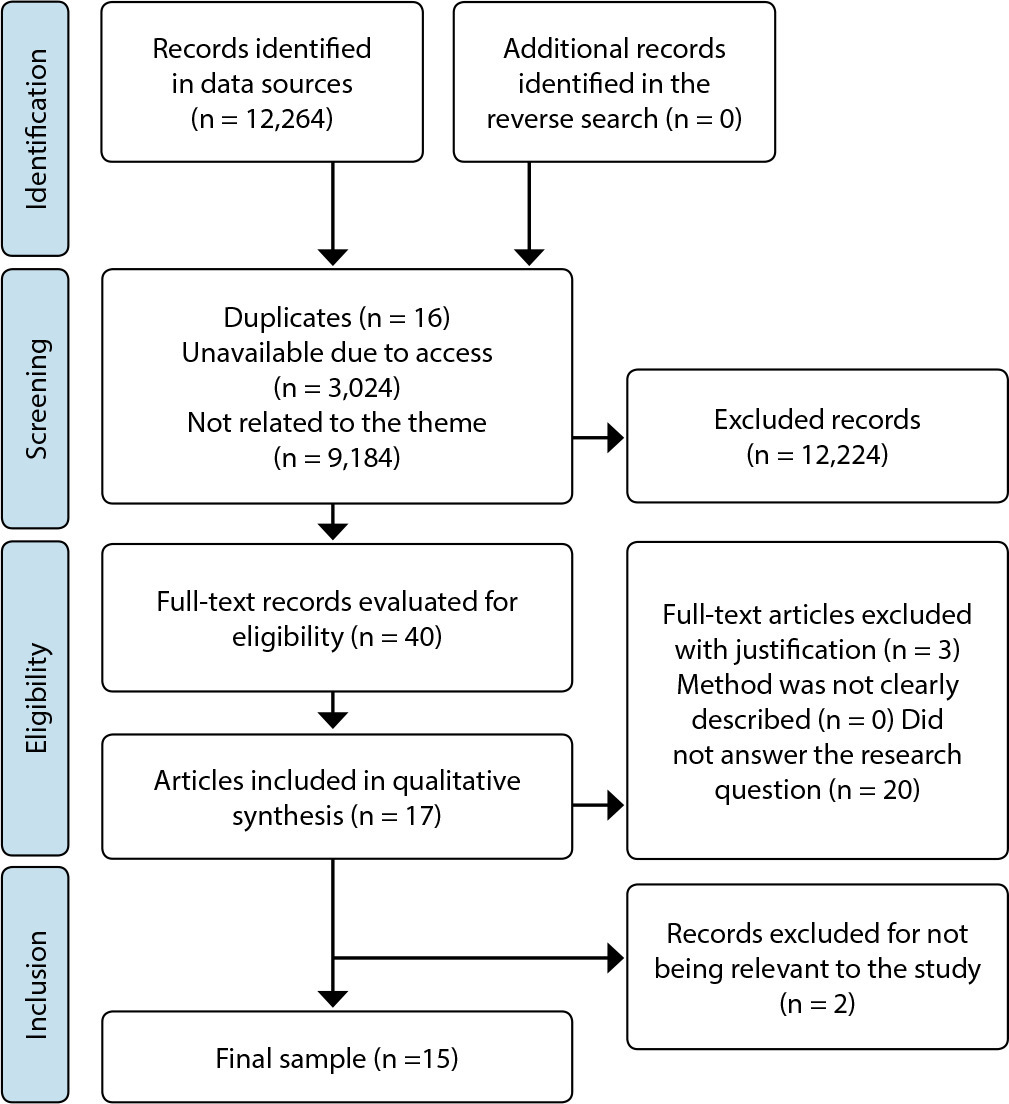
-
ORIGINAL ARTICLE10-09-2023
Comportamentos saudáveis e risco de doenças cardiovasculares entre docentes de enfermagem durante a pandemia de COVID-19
Revista Brasileira de Enfermagem. 2023;76:e20220372
Abstract
ORIGINAL ARTICLEComportamentos saudáveis e risco de doenças cardiovasculares entre docentes de enfermagem durante a pandemia de COVID-19
Revista Brasileira de Enfermagem. 2023;76:e20220372
DOI 10.1590/0034-7167-2022-0372
Views0See moreRESUMEN
Objetivo:
Las enfermedades cardiovasculares son la primera causa de muerte en todo el mundo. La adopción de hábitos de vida que promuevan la salud mantendrá la salud cardiovascular del individuo y reducirá el riesgo de enfermedades cardiovasculares.
Métodos:
En este estudio descriptivo, se encuestó a 150 profesores de enfermería mediante un método de muestreo no probabilístico (intencional) para evaluar su adhesión a un estilo de vida promotor de la salud con el fin de conocer el riesgo de enfermedades cardiovasculares. Para ello, se utilizó la versión árabe del Health-Promoting Lifestyle Profile II (HPLP-II).
Resultados:
Setenta y dos profesores de enfermería completaron la encuesta. Los resultados indicaron que la muestra del estudio tenía un nivel moderado de promoción de la salud basado en el Health-Promoting Lifestyle Profile II.
Conclusión:
Los profesores de enfermería corren el riesgo de desarrollar enfermedades cardiovasculares en función de sus comportamientos de promoción de la salud, ya que obtuvieron una puntuación baja en responsabilidad de salud, actividad física y gestión del estrés. Se recomienda impulsar comportamientos saludables para prevenir enfermedades crónicas como las cardiovasculares.
-
ORIGINAL ARTICLE10-09-2023
Healthy lifestyle behaviors and risk of cardiovascular diseases among nursing faculty during COVID-19 Pandemic
Revista Brasileira de Enfermagem. 2023;76:e20220372
Abstract
ORIGINAL ARTICLEHealthy lifestyle behaviors and risk of cardiovascular diseases among nursing faculty during COVID-19 Pandemic
Revista Brasileira de Enfermagem. 2023;76:e20220372
DOI 10.1590/0034-7167-2022-0372
Views0See moreABSTRACT
Objective:
Cardiovascular diseases are the first ranked cause of death worldwide. Adhering to health promoting lifestyle behaviors will maintain an individual’s cardiovascular health and decrease the risk of cardiovascular diseases.
Methods:
In this descriptive study, 150 nursing faculty were surveyed via a non-probability (purposive) sampling method to assess their adherence to health promoting lifestyle in order to know the risk of cardiovascular diseases. The Arabic version of Health-Promoting Lifestyle Profile II (HPLP-II) was used to achieve this goal.
Results:
Seventy-two nursing faculty completed the survey. The results indicated that the study sample had moderate level of health promotion based on Health-Promoting Lifestyle Profile II.
Conclusion:
Nursing faculty are at risk of developing cardiovascular diseases based on their health promoting lifestyle behaviors as they scored low level of “health responsibility”, “physical activity”, and “stress management “. Encouraging healthy behaviors is recommended to prevent chronic diseases such as cardiovascular diseases.
-
ORIGINAL ARTICLE10-09-2023
Experience of the patient regarding their safety in the hospital environment
Revista Brasileira de Enfermagem. 2023;76(5):e20220512
Abstract
ORIGINAL ARTICLEExperience of the patient regarding their safety in the hospital environment
Revista Brasileira de Enfermagem. 2023;76(5):e20220512
DOI 10.1590/0034-7167-2022-0512
Views0See moreABSTRACT
Objectives:
to analyze the factors that can impact patients’ experience concerning safety-related measures in the hospital setting.
Methods:
this qualitative, descriptive, and exploratory study was conducted with patients and their family members at a hospital in southern Brazil. Semi-structured interviews were carried out using the Critical Incident Technique between January and February 2022. The collected data underwent content analysis with the assistance of IRaMuTeQ software.
Results:
five patients, four family members, and three patient-family units participated in the study. The following categories emerged: “Patientprofessional interaction as a component of safe care,” “Recognition of safety protocols in the patient’s experience,” and “Safe care and the challenges in hospital care.”
Conclusions:
patient-professional interaction, communication, awareness of safety protocols, and the availability of the nursing team are factors that influence patients’ experience regarding the safety of their care during hospitalization.
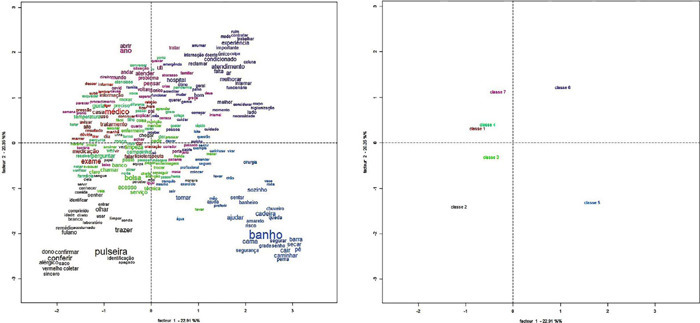
-
ORIGINAL ARTICLE10-09-2023
Validity study of the Three-Dimensional Work Fatigue Inventory among higher education nursing faculty
Revista Brasileira de Enfermagem. 2023;76(4):e20230020
Abstract
ORIGINAL ARTICLEValidity study of the Three-Dimensional Work Fatigue Inventory among higher education nursing faculty
Revista Brasileira de Enfermagem. 2023;76(4):e20230020
DOI 10.1590/0034-7167-2023-0020
Views0See moreABSTRACT
Objective:
to adapt and validate the Three-Dimensional Work Fatigue Inventory (3D-WFI) for Brazil’s cultural reality and assess the psychometric properties.
Methods:
a methodological study developed in six stages: initial translation; synthesis of translations; back translation; review by expert committee; pretest; and review of the adaptation process by the researchers. For validity, the instrument was applied to a sample of 318 nursing professors from Brazilian federal and state public universities. Data were analyzed using exploratory and confirmatory factor analysis, composite reliability and instrument reliability (Cronbach’s alpha and McDonald’s omega).
Results:
the 3D-WFI instrument showed excellent internal consistency (α=0.95 and ω=0.97), three dimensions and explained variance of 62.77%.
Conclusions:
the Brazilian version of the instrument showed excellent psychometric properties for assessing fatigue among Brazilian workers.
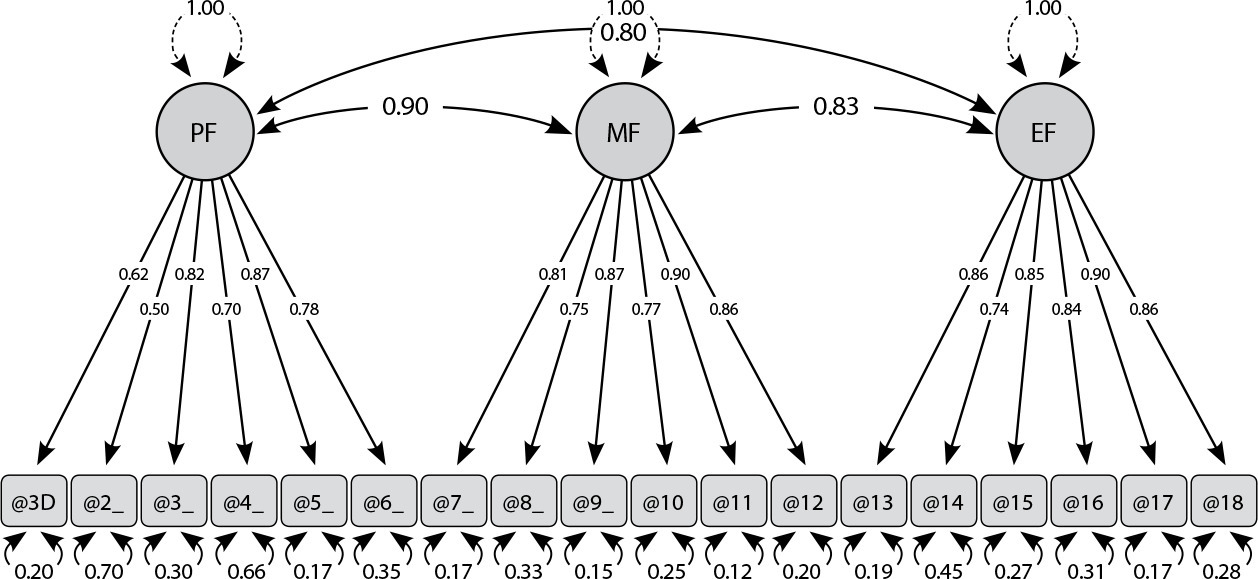
-
ORIGINAL ARTICLE10-09-2023
Construction and validity of an educational video to prevent immunization errors
Revista Brasileira de Enfermagem. 2023;76(4):e20230010
Abstract
ORIGINAL ARTICLEConstruction and validity of an educational video to prevent immunization errors
Revista Brasileira de Enfermagem. 2023;76(4):e20230010
DOI 10.1590/0034-7167-2023-0010
Views0See moreABSTRACT
Objective:
to construct and validate an orientation video, based on a low-fidelity clinical simulation scenario, to prevent immunization errors.
Methods:
a methodological study with video construction, validated in two stages by different audiences. Content was selected based on a realistic simulation scenario of the vaccine administration process to a patient-actor. Items with concordance greater than 0.8 and 0.6 were considered valid, verified using the Content Validity Index (CVI) and the Content Validity Ratio (CVR), respectively.
Results:
judges’ CVI had an average of 97.5%, and CVR, 0.9, and health professionals’ CVI, 95.4%, and CVR, 0.8. Successes in administering vaccines were addressed, such as careful reading of labels, double-checking the vaccine, distractions/interruptions and error reporting.
Conclusions:
the video was constructed and validated in terms of content, and can be used in training professionals working in vaccination.
-
ORIGINAL ARTICLE10-09-2023
Variabilidade glicêmica e mortalidade em unidades de terapia intensiva oncológicas
Revista Brasileira de Enfermagem. 2023;76(4):e20220812
Abstract
ORIGINAL ARTICLEVariabilidade glicêmica e mortalidade em unidades de terapia intensiva oncológicas
Revista Brasileira de Enfermagem. 2023;76(4):e20220812
DOI 10.1590/0034-7167-2022-0812
Views0See moreRESUMEN
Objetivo:
investigar la asociación entre la variabilidad glucémica y la mortalidad en pacientes ingresados en unidades de cuidados intensivos oncológicos.
Métodos:
Se llevó a cabo un estudio de cohorte retrospectivo utilizando una muestra de conveniencia de 30 historias clínicas de pacientes de ambos sexos mayores de 18 años. La variabilidad glucémica se midió utilizando la desviación estándar y la amplitud general. El análisis estadístico se realizó utilizando la curva ROC (receiver operating characteristic) y el área bajo la curva (AUC). El nivel de significancia (α) se estableció en un 5% con un intervalo de confianza (IC) del 95%.
Resultados:
El estudio incluyó a 14 pacientes masculinos (46,67%) con una edad media de 60±15 años. Se recopilaron un total de 1503 muestras de glucemia. El análisis AUC para la desviación estándar no mostró ningún resultado estadísticamente significativo (p = 0,966; IC del 95% = [0,283, 0,726]). Por el contrario, la amplitud general tuvo una asociación estadísticamente significativa con la mortalidad (p = 0,049; IC del 95% = [0,514, 0,916]).
Conclusiones:
Este estudio encontró que la variabilidad glucémica medida por la amplitud general está significativamente asociada con la mortalidad del paciente en unidades de cuidados intensivos oncológicos. Estos hallazgos sugieren que el monitoreo de la variabilidad glucémica puede ser un factor importante en el manejo de pacientes críticamente enfermos en unidades de cuidados intensivos oncológicos.
-
ORIGINAL ARTICLE10-09-2023
Glycemic variability and mortality in oncologic intensive care units
Revista Brasileira de Enfermagem. 2023;76(4):e20220812
Abstract
ORIGINAL ARTICLEGlycemic variability and mortality in oncologic intensive care units
Revista Brasileira de Enfermagem. 2023;76(4):e20220812
DOI 10.1590/0034-7167-2022-0812
Views0See moreABSTRACT
Objective:
This study aimed to investigate the association between glycemic variability and mortality in patients admitted to oncologic intensive care units.
Methods:
A retrospective cohort study was conducted using a convenience sample of 30 medical records of patients over 18 years of age of both sexes. Glycemic variability was measured using the standard deviation and general amplitude. Statistical analysis was performed using the receiver operating characteristic (ROC) curve and the area under the curve (AUC). The significance level (α) was set at 5% with a confidence interval (CI) of 95%.
Results:
The study included 14 male patients (46.67%) with a mean age of 60±15 years. A total of 1503 blood glucose samples were collected. The AUC analysis for the standard deviation did not show a statistically significant result (p=.966; 95% CI=[0.283, 0.726]). In contrast, the general amplitude had a statistically significant association with mortality (p=.049; 95% CI=[0.514, 0.916]).
Conclusions:
This study found that glycemic variability measured by the general amplitude was significantly associated with patient mortality in oncologic intensive care units. These findings suggest that monitoring glycemic variability may be an important factor in the management of critically ill patients in oncologic intensive care units.

-
REVIEW01-01-2017
Nursing process in mental health: an integrative literature review
Revista Brasileira de Enfermagem. 2017;70(1):220-230
Abstract
REVIEWNursing process in mental health: an integrative literature review
Revista Brasileira de Enfermagem. 2017;70(1):220-230
DOI 10.1590/0034-7167-2016-0031
Views0See moreABSTRACT
Objective:
to identify evidences from the literature on the application of nursing process in care developed by the nurse in mental health.
Method:
integrative literature review between 1990 and 2013, in the PubMed, Scopus, CINAHL and LILCACS bases. Descriptors: nursing processes, mental health, nursing care.
Results:
19 papers were identified. Limited and partial usage of the nursing process in care established by a therapeutic relationship that respects the patient’s individuality. We observe care proposals systematized for patients that present pathological aspects in the limits between the physical and psychical, which might be a response to the influence of the practice based on evidences.
Conclusion:
it was found an antagonistic movement between care based on the relationship and located in the standardization of diagnoses that respond to physical malaise. A lack of evidence was verified for the usage of the nursing process in mental health, and we point at the necessity for the creation of new possibilities for dialogue between relational and biological perspectives.
-
REVIEW01-01-2017
Nursing practice in home care: an integrative literature review
Revista Brasileira de Enfermagem. 2017;70(1):210-219
Abstract
REVIEWNursing practice in home care: an integrative literature review
Revista Brasileira de Enfermagem. 2017;70(1):210-219
DOI 10.1590/0034-7167-2016-0214
Views0See moreABSTRACT
Objective:
analyze scientific production on nursing practice in home care.
Method:
integrative review employing databases LILACS, BDENF, IBECS, and MEDLINE. Studies in Spanish, English, and Portuguese were included, regardless of publishing date.
Results:
after analyzing 48 articles, it was found that nursing practice in home care is complex, employing a multitude of actions by using three technologies: soft; soft-hard especially; and hard. Challenges related to the home-care training process are reported in the literature. Nurses use knowledge from their experience and scientific recommendations in conjunction with their reflections on the practice.
Conclusion:
home nursing practice is fundamental and widespread. Relational and educational actions stand out as necessary even in technical care, with a predominant need for home-care training.
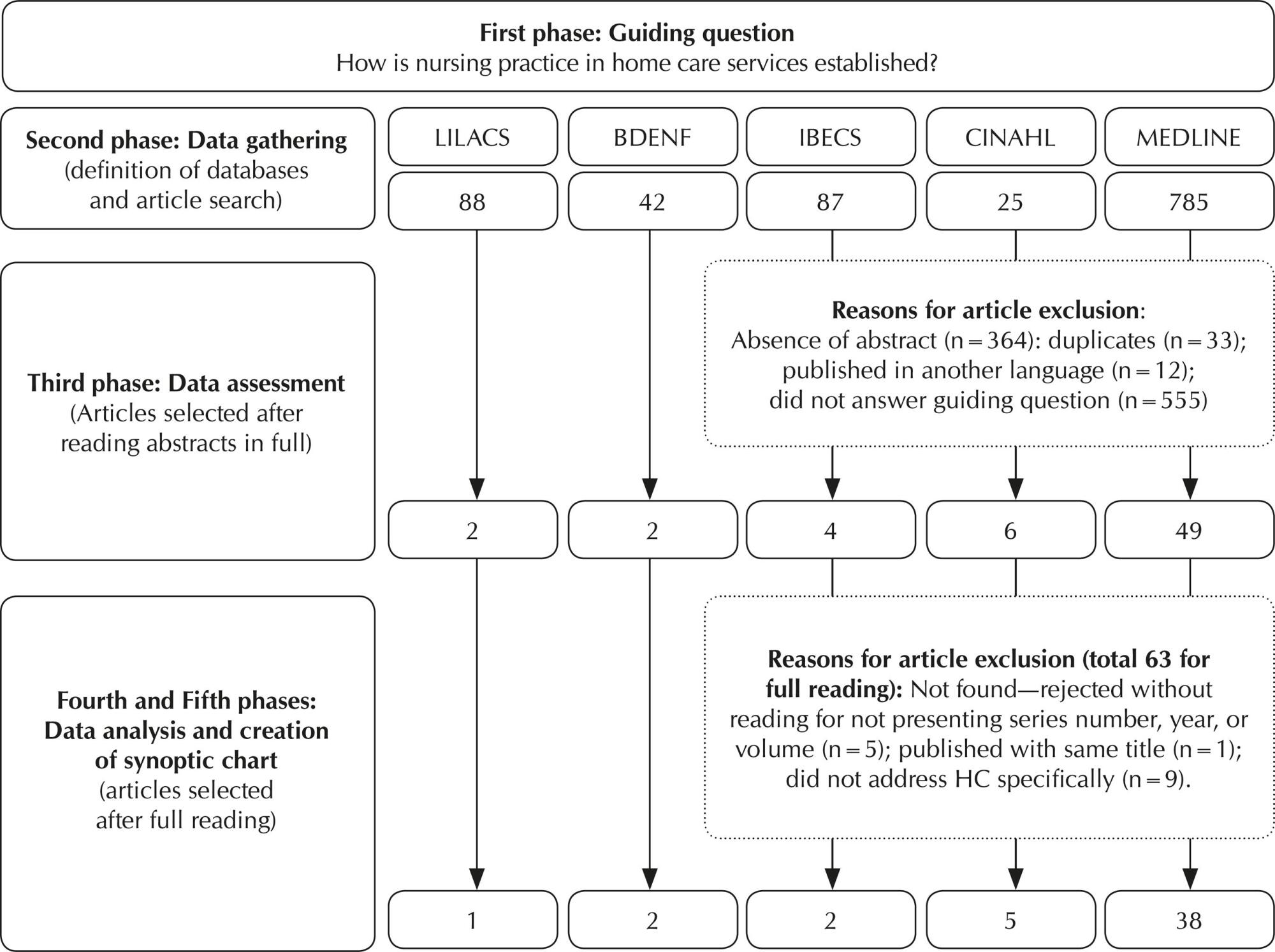
-
REVIEW01-01-2017
Nonpharmacological interventions to improve quality of life in heart failure: an integrative review
Revista Brasileira de Enfermagem. 2017;70(1):198-209
Abstract
REVIEWNonpharmacological interventions to improve quality of life in heart failure: an integrative review
Revista Brasileira de Enfermagem. 2017;70(1):198-209
DOI 10.1590/0034-7167-2016-0112
Views0See moreABSTRACT
Objective:
to identify articles that assessed the effectiveness or efficacy of nonpharmacological interventions to improve quality of life of people with heart failure in the literature.
Method:
an integrative literature review was performed in Lilacs, MedLine and SciELO databases, including randomized or nonrandomized clinical trials and quasi-experimental studies published between 2003 and 2014, in Portuguese, English or Spanish.
Results:
twenty-three studies were included. The categories of nonpharmacological interventions that improved quality of life of people with heart failure were: Remote health monitoring, Instructions on health practices, Physical activity follow-up and Traditional Chinese Medicine practices.
Conclusion:
these results can guide the selection of interventions to be implemented by health professionals that treat people with heart failure. Future systematic reviews with meta-analyses are needed in order to identify the most effective interventions for improving these individuals’ quality of life.
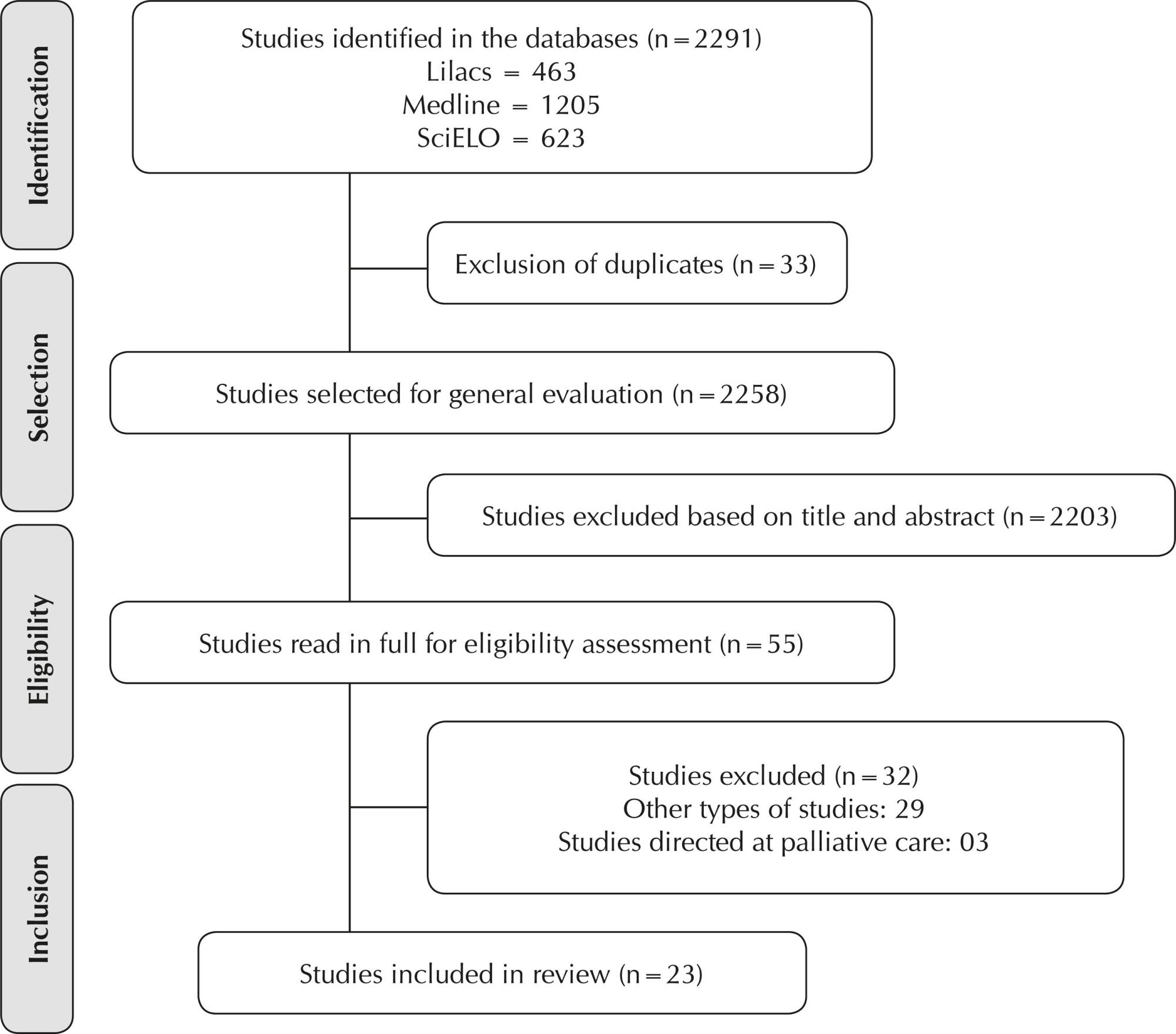
-
REVIEW01-01-2017
Quality of working life: assessment of intervention studies
Revista Brasileira de Enfermagem. 2017;70(1):189-197
Abstract
REVIEWQuality of working life: assessment of intervention studies
Revista Brasileira de Enfermagem. 2017;70(1):189-197
DOI 10.1590/0034-7167-2015-0069
Views0See moreABSTRACT
Objective:
to analyze the production of knowledge about interventions on quality of working life.
Method:
integrative review study. The following databases were used for study selection: SciELO, Medline and PubMed.
Results:
the sample included 25 national and international articles that described programs and methods to acquire healthy habits at the workplace and attenuate its mental demands.
Conclusion:
by observing the number of businesses throughout the world, a low number of programs addressing workers’ health and well-being can be found, and the establishment of efficient policies at institutions could improve this situation.
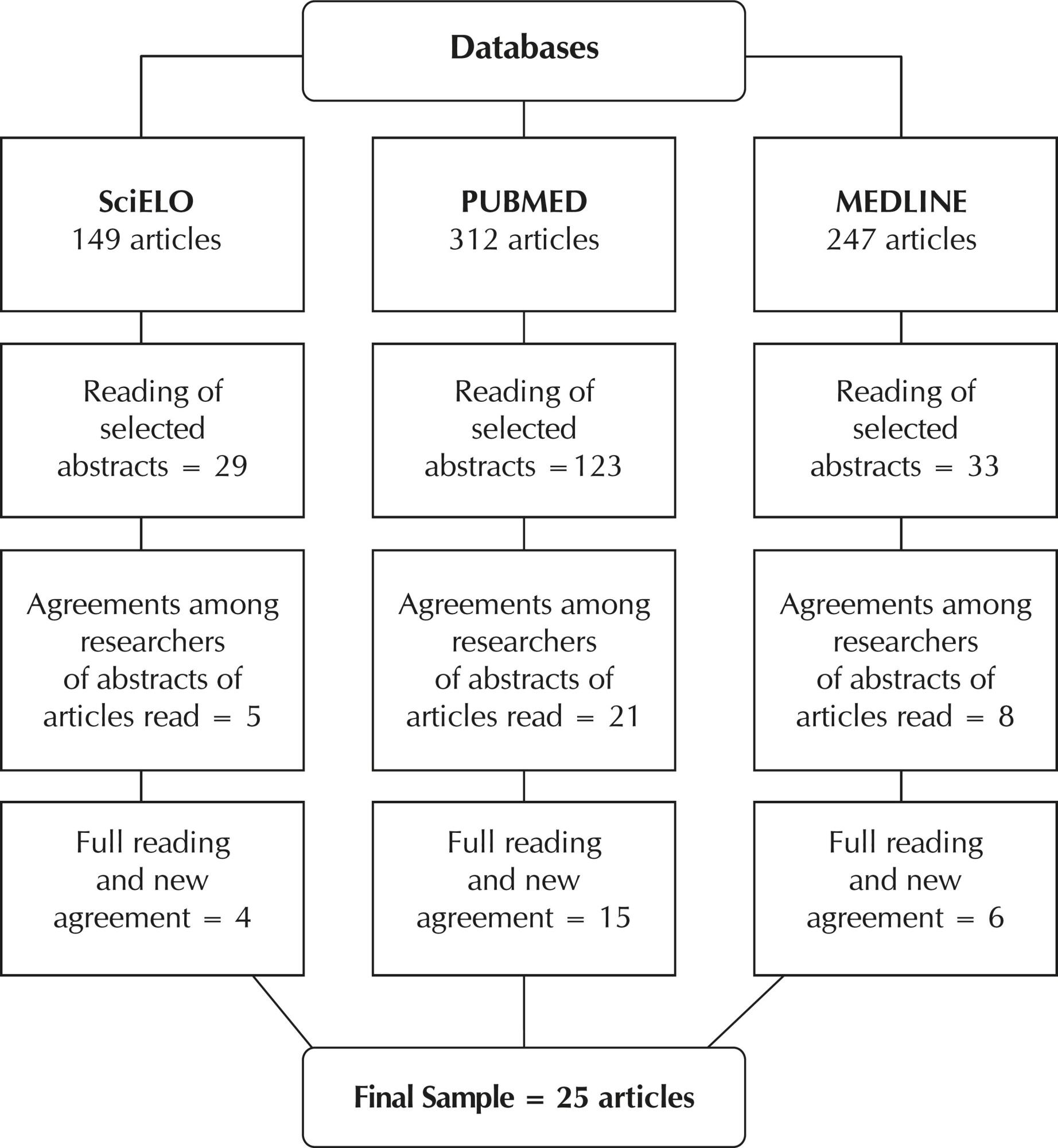
-
REVIEW01-01-2017
Letramento em saúde para pessoas com HIV/Aids: revisão integrativa
Revista Brasileira de Enfermagem. 2017;70(1):180-188
Abstract
REVIEWLetramento em saúde para pessoas com HIV/Aids: revisão integrativa
Revista Brasileira de Enfermagem. 2017;70(1):180-188
DOI 10.1590/0034-7167-2015-0052
Views1See moreRESUMEN
Objetivo:
analizar el conocimiento producido por la investigación sobre la salud de alfabetización para adultos con VIH/SIDA.
Método:
una revisión integradora de la literatura, con seis bases de datos, se llevó a cabo entre enero y abril de 2014. Los descriptores SIDA y Educación de la Salud se utilizaron, en portugués, inglés y español. Se encontró un total de 130 artículos y se seleccionaron 14. Se identificaron tres categorías: tecnologías de la educación y alfabetización de la salud para el VIH/SIDA; evaluación de conocimientos sobre la salud de los pacientes con VIH/SIDA; y conocimientos sobre la salud y la adherencia a la terapia antirretroviral.
Resultados:
análisis de los conocimientos sobre la salud, el estatus socioeconómico y nivel educativo de las personas que viven con el VIH / SIDA era esencial para la implementación de estrategias educativas que el aumento de la adherencia a la orientación de la salud.
Conclusión:
Este estudio demostró la importancia de la alfabetización en salud para trabajar con personas que viven con el VIH / SIDA, especialmente teniendo en cuenta a las personas que no poseen el mínimo necesario para la supervivencia, lo que hace que sea aún más relevante y alienta la investigación sobre el tema.
-
REVIEW01-01-2017
Health literacy for people living with HIV/Aids: an integrative review
Revista Brasileira de Enfermagem. 2017;70(1):180-188
Abstract
REVIEWHealth literacy for people living with HIV/Aids: an integrative review
Revista Brasileira de Enfermagem. 2017;70(1):180-188
DOI 10.1590/0034-7167-2015-0052
Views0See moreABSTRACT
Objective:
to analyze knowledge produced by research about health literacy for adult with HIV/Aids.
Method:
an integrative literature review, using six databases, was conducted between January and April of 2014. The descriptors aids and Health Literacy were used, in Portuguese, English and Spanish. A total of 130 articles were found and 14 were selected. Three categories were identified: educational technologies and health literacy for HIV/Aids; assessment of health literacy of patients with HIV/Aids; and health literacy and adherence to antiretroviral therapy.
Results:
analysis of health literacy, socioeconomic status and educational level of people living with HIV/ Aids was essential for implementation of educational strategies that increased adherence to health guidance.
Conclusion:
this study showed the importance of health literacy for working with people living with HIV/Aids, especially considering individuals who did not possess the minimum necessary for survival, which makes it relevant and encourages further research on the topic.
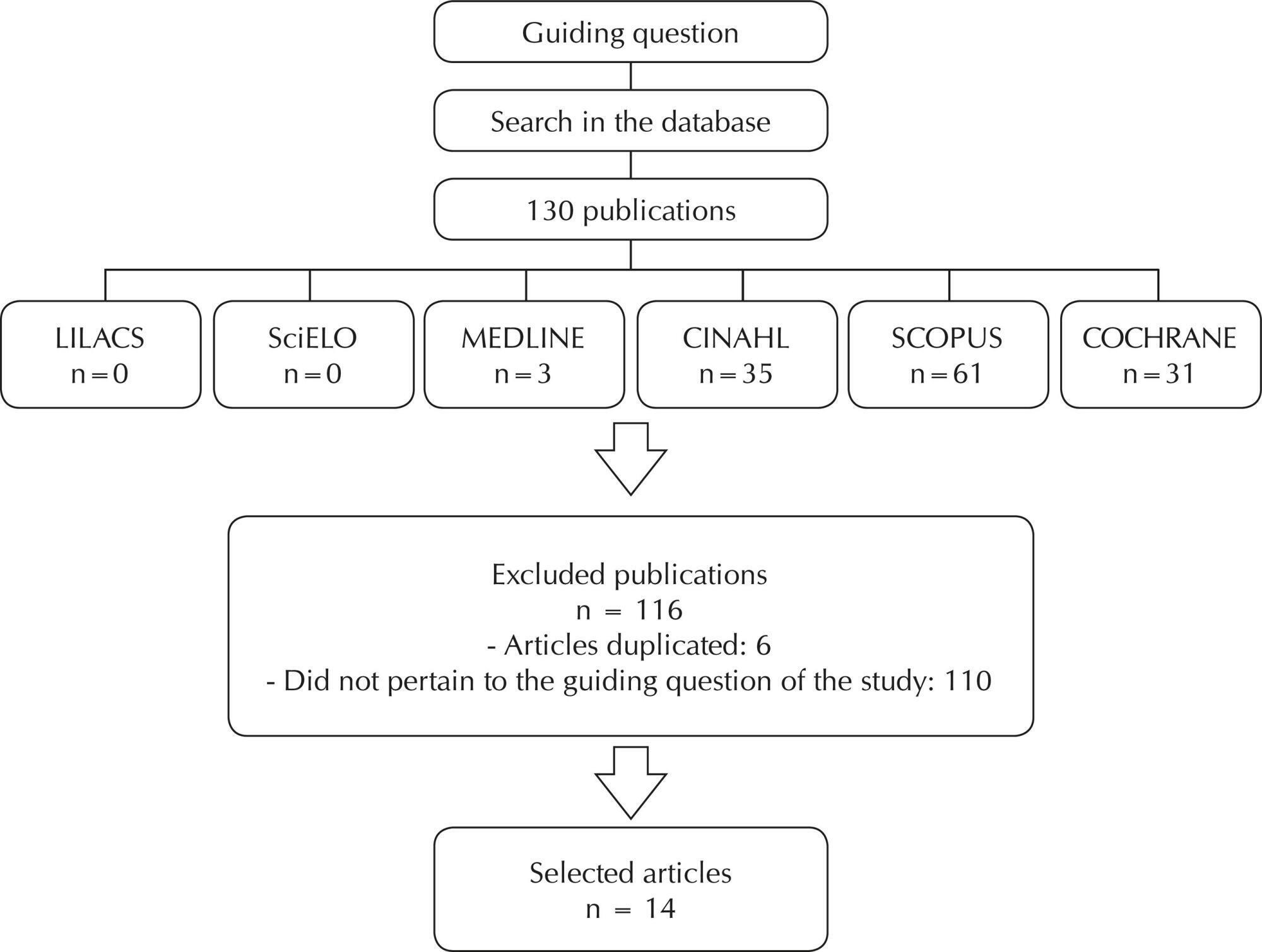
-
Factors that interfere with the response of nurses in the monitoring of clinical alarms
Revista Brasileira de Enfermagem. 2017;70(1):172-179
Abstract
Factors that interfere with the response of nurses in the monitoring of clinical alarms
Revista Brasileira de Enfermagem. 2017;70(1):172-179
DOI 10.1590/0034-7167-2015-0092
Views0See moreABSTRACT
Objective:
The objective of the present study was to identify and synthesize the best empirical evidence found on factors that influence the response of nurses regarding clinical alarms.
Method:
An integrative literature review was conducted with searches undertaken in ten electronic databases restricted to the period from 2005 to 2016.
Results:
Eight articles were included by cross-checking the descriptors selected.
Conclusion:
In the analysis of the studies, the following possible factors that might interfere with the response of nurses in the monitoring of clinical alarms were found: high number of false alarms, inaudibility of alarms due to the competition of sounds, difficulty in distinguishing the urgency of alarms, and increase in noise caused by the raise in the number of alarms.
-
RESEARCH01-01-2017
Discourses on discharge care for children with special healthcare needs
Revista Brasileira de Enfermagem. 2017;70(1):163-171
Abstract
RESEARCHDiscourses on discharge care for children with special healthcare needs
Revista Brasileira de Enfermagem. 2017;70(1):163-171
DOI 10.1590/0034-7167-2016-0248
Views0See moreABSTRACT
Objectives:
analyze the discourse of healthcare professionals and families on the continuous and complex care for children with special healthcare needs; understand hospital discharge as a process centered on children demands and family learning.
Method:
qualitative research conducted between 2013 and 2015 through semi-structured interviews, document analysis and the sensitive creative method; the participants were ten children with special healthcare needs, six professionals and eleven family members from a public pediatric teaching hospital in Rio de Janeiro. The data underwent critical discourse analysis.
Results:
at discharge, family caregivers should learn innovative care to guarantee the maintenance of their children’s lives at home, but preparation is limited.
Conclusion:
the clinicians and the families pointed out Nurse as the most qualified professional for this preparation, since caring for these children requires nursing care skills.
-
ORIGINAL ARTICLE01-10-2024
Childbirth dynamics in the riverside region of the Brazilian Amazon from the perspective of geospatialization
Revista Brasileira de Enfermagem. 2024;77:e20240038
Abstract
ORIGINAL ARTICLEChildbirth dynamics in the riverside region of the Brazilian Amazon from the perspective of geospatialization
Revista Brasileira de Enfermagem. 2024;77:e20240038
DOI 10.1590/0034-7167-2024-0038
Views0See moreABSTRACT
Objective:
to analyze the spatial-temporal pattern of childbirths and flow of postpartum women assisted at a regional reference maternity hospital.
Methods:
ecological study of 4,081 childbirths, between September 2018 and December 2021, at a public maternity hospital in the Baixo Tocantins region, Pará, Brazil. With data collected from five sources, a geographic database was constructed, and spatial analysis was used with Kernel density interpolator. Maps were generated using QGis/3.5 and TerraView/4.3, calculating chi-square (p<0.05).
Results:
the highest concentrations of normal and cesarean childbirths were observed in Barcarena (n=2,558/62.68%), Abaetetuba (n=750/18.38%), Moju (n=363/8.89%) and Igarapé-Miri (n=219/5.37%). Among the municipalities in the region, ten had obstetric beds, totaling 210 beds. In this scenario, postpartum women traveled up to 288 km to reach the maternity hospital.
Conclusions:
long distances between certain municipalities of residence and maternity hospital, and low supply of obstetric beds, were identified as risk factors for unfavorable obstetric outcomes.
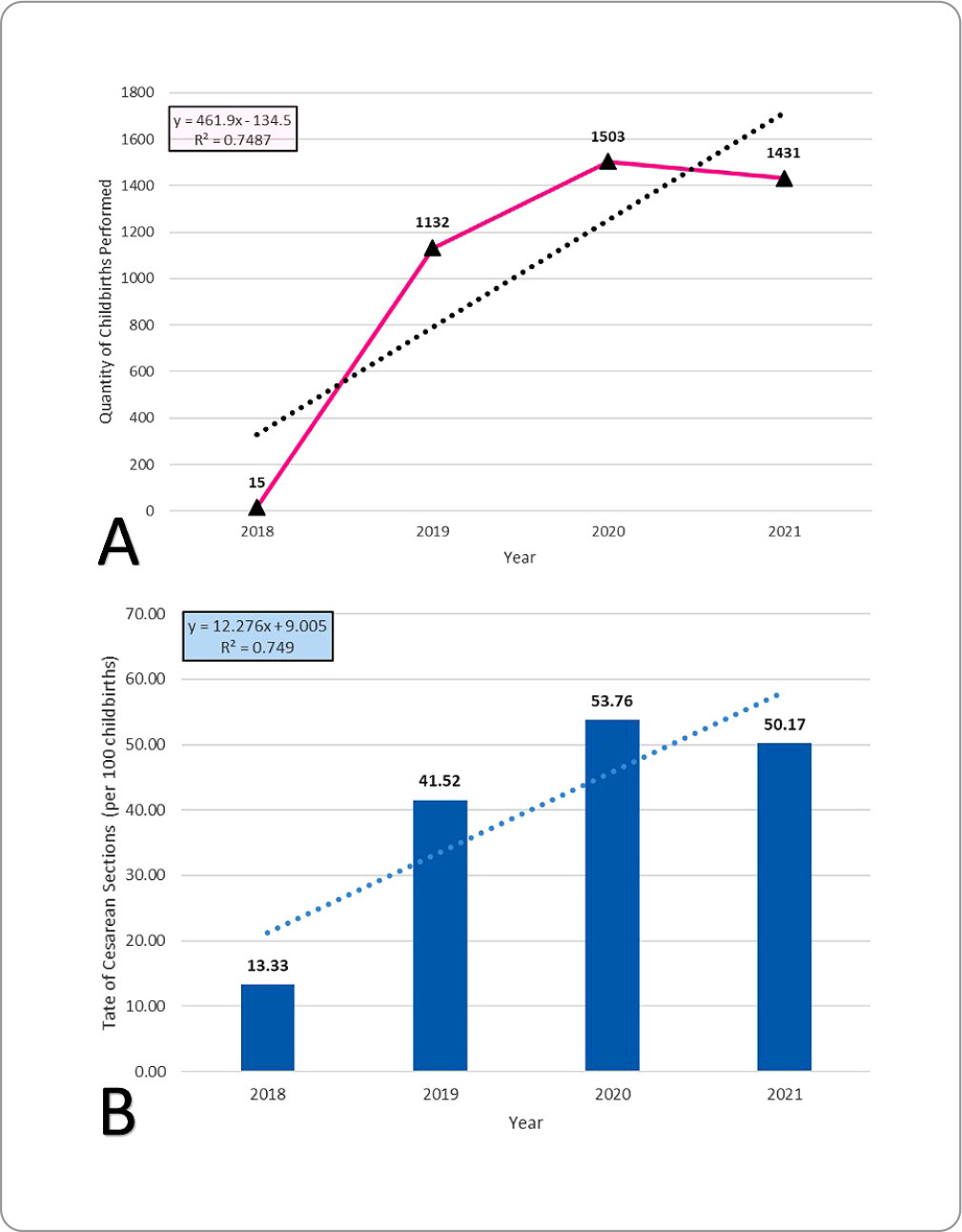
-
REVIEW01-10-2024
Nurses’ practical contributions to improving healthy and sustainable public spaces: an integrative review
Revista Brasileira de Enfermagem. 2024;77:e20240023
Abstract
REVIEWNurses’ practical contributions to improving healthy and sustainable public spaces: an integrative review
Revista Brasileira de Enfermagem. 2024;77:e20240023
DOI 10.1590/0034-7167-2024-0023
Views0ABSTRACT
Objective:
to identify knowledge production about nurses’ contributions to improving healthy and sustainable public spaces.
Methods:
an integrative review carried out in February 2023 in electronic databases. Studies that answered the research question and that were available in full, in Portuguese, English and Spanish, were included.
Results:
a total of five articles were selected. The findings highlighted the importance of educational projects in the training of local managers and community autonomy; citizen participation and health promotion as ways to implement Sustainable Development Goal 11; nurses as facilitators of collective care; new health practices and modes of producing subjectivity; and use of public transportation, bicycles and/or walking in these spaces.
Final considerations:
there is a clear need for greater incentives from local governments to develop effective sustainability strategies that are led by nurses and the community.
Keywords:AttitudesCommunity HealthHealth KnowledgeHealthy Lifestyle, NursesNursesPracticeSustainable DevelopmentSee more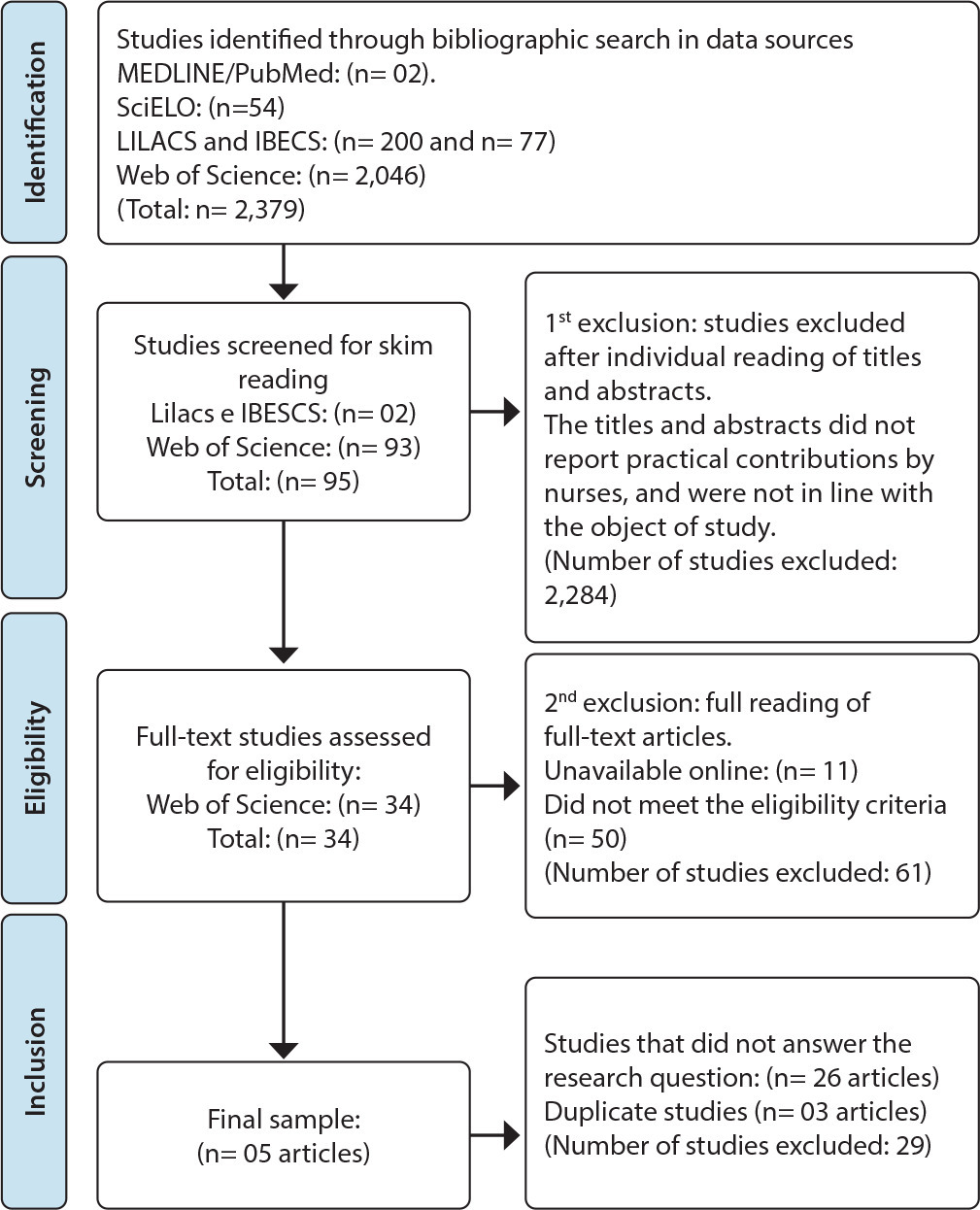
-
ORIGINAL ARTICLE01-10-2024
Pain management in hospitalized infants: recommendations for achieving the Sustainable Development Goals
Revista Brasileira de Enfermagem. 2024;77:e20230421
Abstract
ORIGINAL ARTICLEPain management in hospitalized infants: recommendations for achieving the Sustainable Development Goals
Revista Brasileira de Enfermagem. 2024;77:e20230421
DOI 10.1590/0034-7167-2023-0421
Views0See moreABSTRACT
Objective:
to assess pain management in infants in a Neonatal Intensive Care Unit (NICU) and discuss its articulation with the Sustainable Development Goals, with a focus on promoting neonatal well-being.
Method:
a documentary study, retrospective in nature and quantitative approach, conducted in a NICU of a public hospital in Paraná, Brazil, between January and July 2022, with 386 medical records of infants, hospitalized for more than 24 hours, between 2019 and 2021. Data were subjected to descriptive and inferential analysis, considering p-value<0.05 as a statistical difference. National ethical guidelines were respected.
Results:
all infants underwent at least one painful procedure, but only 13.7% had documented pain. Pharmacological interventions, such as fentanyl (25.9%), and non-pharmacological interventions, such as breastfeeding encouragement (86%) were used. Only 2.8% were reassessed.
Conclusion:
there was a devaluation of neonatal pain management that may perpetuate neonatal well-being and sustainable development.
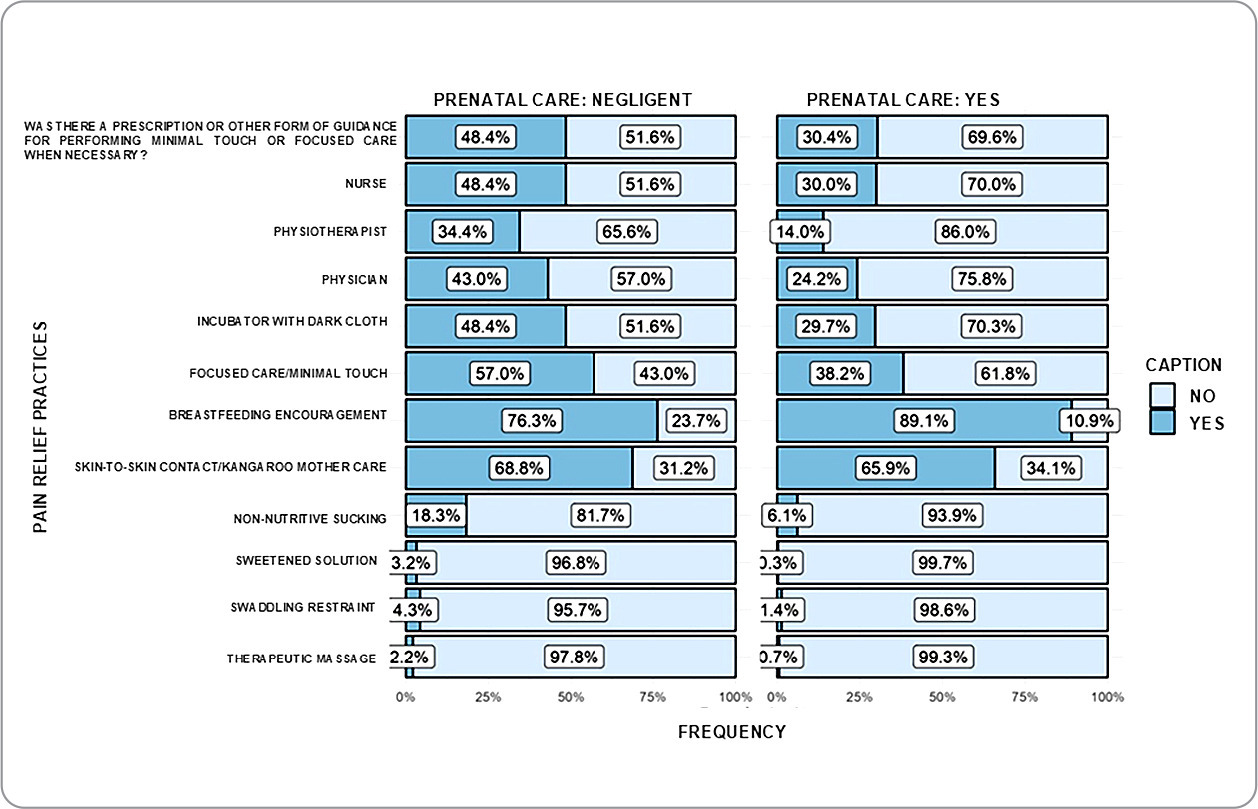
-
LETTER TO THE EDITOR01-10-2024
Adherence to COVID-19 vaccination during the pandemic and fake news: Correspondence
Revista Brasileira de Enfermagem. 2024;77:e202477Suppl101c
Abstract
LETTER TO THE EDITORAdherence to COVID-19 vaccination during the pandemic and fake news: Correspondence
Revista Brasileira de Enfermagem. 2024;77:e202477Suppl101c
-
LETTER TO THE EDITOR01-10-2024
Adherence to COVID-19 vaccination during the pandemic and fake news: Correspondence
Revista Brasileira de Enfermagem. 2024;77:e202477Suppl101c
Abstract
LETTER TO THE EDITORAdherence to COVID-19 vaccination during the pandemic and fake news: Correspondence
Revista Brasileira de Enfermagem. 2024;77:e202477Suppl101c
DOI 10.1590/0034-7167.202477Suppl101c
Views0Dear Dr Dulce Aparecida BarbosaEditor in Chief of the Revista Brasileira de Enfermagem[…]See more -
ORIGINAL ARTICLE01-10-2024
Clinical and epidemiological characteristics and outcomes of patients affected by COVID-19 in the Intensive Care Unit
Revista Brasileira de Enfermagem. 2024;77:e20230527
Abstract
ORIGINAL ARTICLEClinical and epidemiological characteristics and outcomes of patients affected by COVID-19 in the Intensive Care Unit
Revista Brasileira de Enfermagem. 2024;77:e20230527
DOI 10.1590/0034-7167-2023-0527
Views0See moreABSTRACT
Objective:
To understand the clinical and epidemiological characteristics, outcomes, and nursing care of adult patients affected by COVID-19 in the Intensive Care Unit.
Methods:
This is a quantitative, retrospective, and descriptive study. The study participants were clinical and epidemiological statistical reports. Variables analyzed included age, gender, race, comorbidities, signs and symptoms, length of hospital stay, use of mechanical ventilation, medications, infections, monitoring, invasive devices, positioning, diet, comfort, and clinical outcomes.
Results:
The majority of individuals were men, of white race, with a mean age of 63 years, hypertensive, diabetic, and obese. The average length of hospital stay was 16 days. Most required invasive mechanical ventilation, vasopressor drugs, sedoanalgesia, and neuromuscular blockers.
Conclusion:
Nursing care is related to monitoring, ventilation, medication administration, installation of devices, prone positioning, diet administration, and providing comfort.
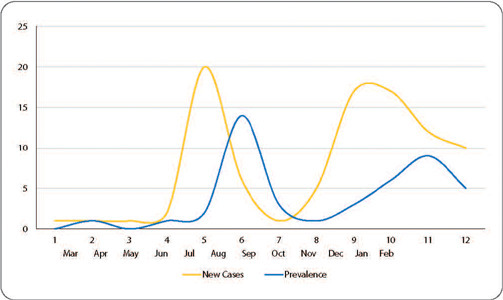
-
ORIGINAL ARTICLE01-10-2024
Morbidity and factors associated with frailty in post-COVID-19 elderly patients attended at a reference center
Revista Brasileira de Enfermagem. 2024;77:e20230454
Abstract
ORIGINAL ARTICLEMorbidity and factors associated with frailty in post-COVID-19 elderly patients attended at a reference center
Revista Brasileira de Enfermagem. 2024;77:e20230454
DOI 10.1590/0034-7167-2023-0454
Views0See moreABSTRACT
Objective:
To assess the morbidity profile and identify factors associated with frailty syndrome in post-COVID-19 elderly patients treated at the only Reference Center for Elderly Health Care in northern Minas Gerais.
Methods:
This is a case series study, utilizing the Clinical-Functional Vulnerability Index-20 (CFVI-20) and Comprehensive Geriatric Assessment (CGA) to characterize and evaluate the health condition of the group. To define the variables associated with frailty, a multivariate analysis was conducted.
Results:
The study included 204 elderly individuals, with a predominance of females (63.7%). The variables associated with frailty were cognitive impairment (OR: 2.95; 95% CI: 1.12-7.80; p=0.029), the presence of five or more comorbidities (OR: 11.55; 95% CI: 2.22-60.01; p=0.004), and impairment in instrumental activities of daily living (OR: 41.97; 95% CI: 5.47-321.93; p<0.001).
Conclusions:
The results of this study highlight the need for a well-established and prepared coordination of integrated care to meet the demands of the post-COVID-19 elderly population.
-
ORIGINAL ARTICLE01-10-2024
Nursing care management strategies to address the COVID-19 pandemic
Revista Brasileira de Enfermagem. 2024;77:e20230254
Abstract
ORIGINAL ARTICLENursing care management strategies to address the COVID-19 pandemic
Revista Brasileira de Enfermagem. 2024;77:e20230254
DOI 10.1590/0034-7167-20230254
Views0See moreABSTRACT
Objective:
To characterize nursing care management strategies for addressing the COVID-19 pandemic.
Method:
A descriptive, qualitative study conducted with 22 nurse professionals at a University Hospital in Southern Brazil. Data collection through interviews in June and August 2021, analyzed according to Bardin’s Content Analysis and the theoretical framework of complex thinking.
Results:
The identified strategies were organized into four categories: Reorganization of health services; People management and emergency admission; Multiprofessional articulation; and Bedside nursing care.
Final Considerations:
Professional performance revealed a complex interplay between leadership and care management practices, even in the face of working condition restrictions, and were understood as crucial in the pandemic scenario.
Search
Search in:
Nuvem de Tags
Aged (144) Atenção Primária à Saúde (239) COVID-19 (104) Cuidados de Enfermagem (269) Educação em Enfermagem (151) Educação em Saúde (139) Enfermagem (930) Estudos de Validação (131) Health Education (144) Idoso (208) Mental Health (149) Nursing (987) Nursing Care (306) Patient Safety (151) Primary Health Care (284) Qualidade de Vida (104) Quality of Life (106) Saúde Mental (145) Segurança do Paciente (150) Validation Studies (108)



